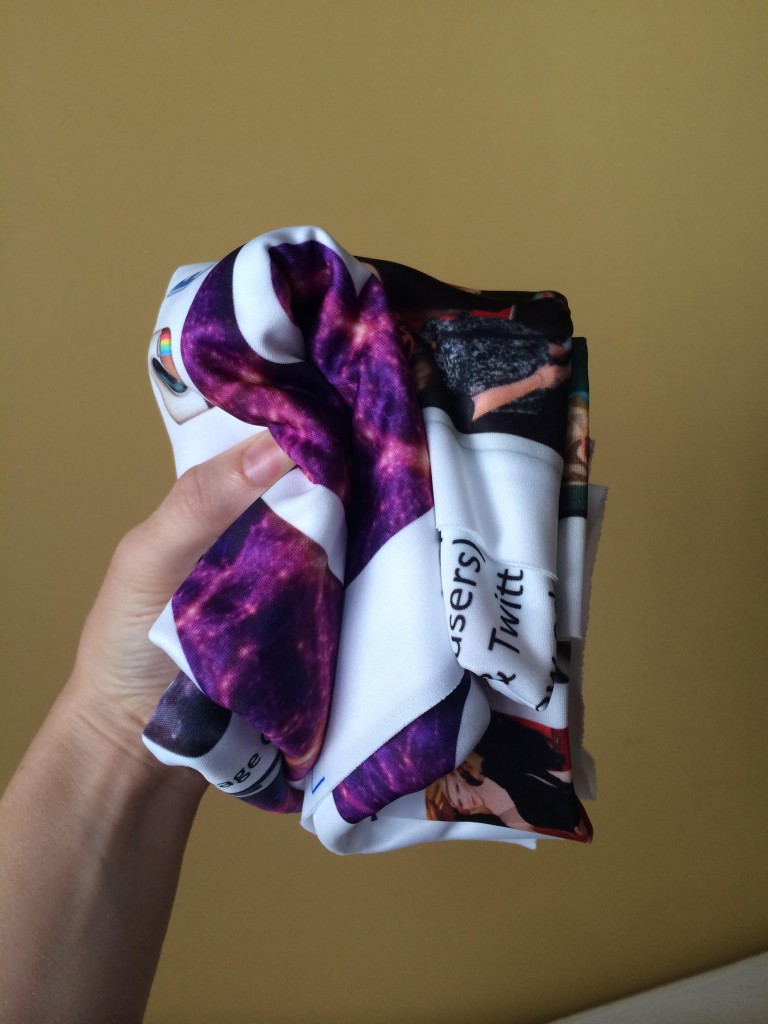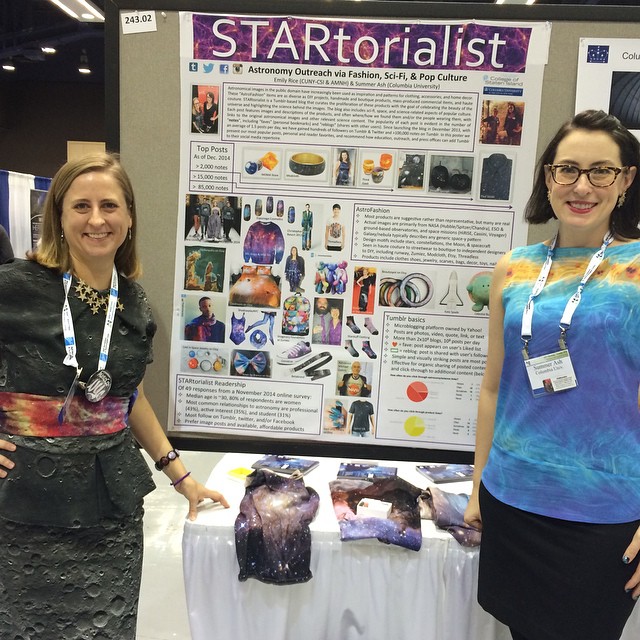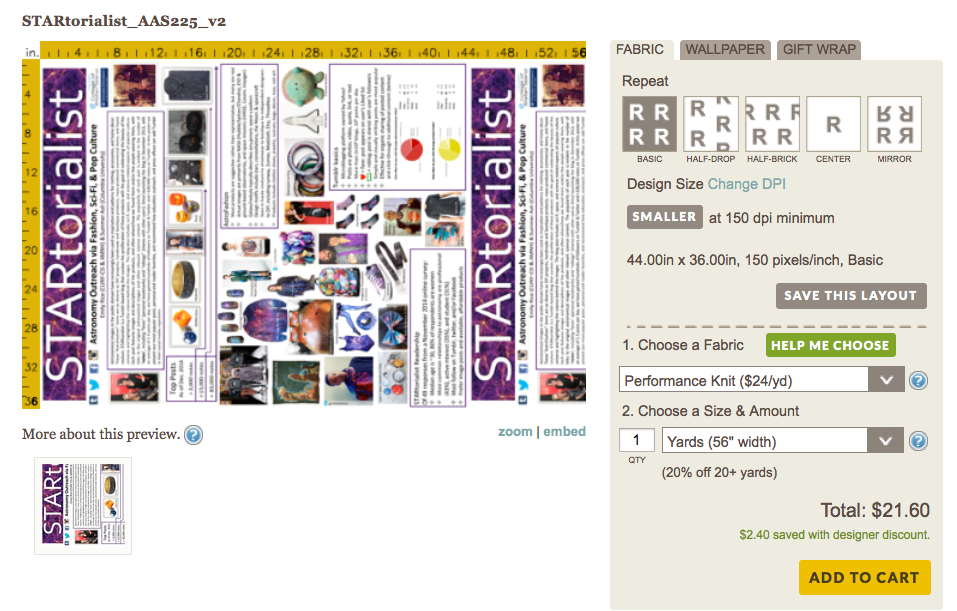Emily Rice is an assistant professor at the College of Staten Island and a research associate at the American Museum of Natural History. She is also responsible for those parody songs that get stuck in your head.
Dearest Colleagues, I have printed my last paper conference poster and carried my last poster tube. Forsooth I have discovered the fabric poster, and I will never look back! Fabric posters are high print quality, cheaper than paper posters, and so much easier to transport. The only downside is that you need to order them at least a week in advance for the best product.
Fabric posters are increasingly popular at conferences, and there are many sources online. After being impressed by Caroline Morley’s poster at Cool Stars 18 I was ready to take the plunge for STARtorialist at AAS 225. I did some limited scoping of other fabric posters at AAS 225, and as far as I can tell the clear winner is what I tried: Performance Knit fabric from Spoonflower.

The poster arrived slightly creased from being folded in the shipping envelope, but the creases disappeared after a short time spread out on the hotel bed. The fabric is light but sturdy, smooth to the touch, and only slightly stretchy. The printed images are vibrant and crisp. Even the smallest fonts I used (24 point native, ~14-16 point in a pasted image), appeared clear and legible. The poster hung easily without drooping (proof), and I even could carry it in my bag during the rest of the conference (the best response to “Sorry I missed your poster” is definitely: “Don’t worry, I have it right here!”). If you’re afraid no one will recognize you at the airport without your trusty poster tube, you can wear your poster as a cape or a scarf! Just make sure to submit a photo to STARtorialist.

Printing via Spoonflower can be intimidating if you don’t have experience printing or buying fabric, but they have detailed instructions for creating the proper file. The most important thing is to make your file 150 dpi and the size you’d like it to print (higher dpi isn’t better for fabric printing). Fabric is typically sold by the yard (length), and the width is determined by the type of fabric. On Spoonflower the fabric widths vary from 42″ to 58″ (the performance knit is 56” wide). By creating your poster 36” in one dimension you can purchase just one yard of fabric. The AAS poster limit is 44” by 44” so I recommend making the poster 36” wide by 44” tall, then rotate your poster image for printing. If you select “Basic Repeat” under the printing options, you’ll have the top 12” of your poster repeated on the bottom – nice motivation for creating an aesthetically pleasing header. For display at AAS 225 I simply pinned the extra fabric behind the poster. Alternately you could make the poster 44” wide and trim the extra fabric. The preview feature makes it easy to check that your poster will print they way you want (see below). Best of all, one yard of performance knit fabric is just $21.60 ($24 less the 10% discount for designing your own fabric).

The downside with Spoonflower is the printing/shipping time: you’ll need to have your poster finished a week before the conference. Spoonflower’s standard printing turnaround time changes depending on their order volume. Today the turnaround estimate is 7 to 8 days, which is an eternity in pre-conference preparation time. Guaranteed Delivery arrives two days after it is shipped but doesn’t rush the printing. Rush Delivery orders placed by noon EST will be shipped the next business day so that’s the way to go. Before AAS 225 I placed my order on December 24, it shipped December 29 and arrived December 31. For one yard/poster the costs are \$3 for standard shipping, \$15 for Guaranteed Delivery, and \$25 for Rush Delivery. Shipping costs are determined by weight so combining orders can decrease the cost: I tested 2 yards (\$6, \$15, \$25), 3 yards (\$6, \$28, \$48), and 4-6 yards (\$7, \$28, $48). That can bring your cost down to $30 per poster, including Rush Delivery!
At AAS 225 I also saw a Spoonflower-printed combed cotton poster and several PosterSmith posters. The cotton fabric from Spoonflower costs slightly less, but it was thin and off-white with visible fibers. PosterSmith received positive reviews for fast printing and shipping (received in two days in rural Pennsylvania!), but the price is similar to Fedex Office ($118 for a 42” by 42” poster, shipping included), and the quality was decent but not stunning. The print looked good – vibrant colors and crisp lines – but the posters were stiff and some had creases that wouldn’t budge. Spoonflower has many more fabric options to try, but I’ll be sticking with the performance knit.
Have you printed a fabric poster from Spoonflower, PosterSmith, or another service? Share your reviews in the comments!
As a bonus, recycling fabric posters is a lot more fun! For example:
I printed two posters on Spoonflower fabric for AAS! The cheap cotton one was one of mine – in addition to looking like newsprint, I had to iron it and that still didn’t get all the wrinkles out.
I also had a performance knit one, and it was great! The only issue I had was a snag in the middle, but I put a line of clear nail polish across the back to prevent further pulling and snipped the offending thread from the front, and it was barely noticeable. That was a small price to pay for the convenience of a) no poster tube, and b) being able to carry my poster around in my purse all week. I trimmed the edges so I had a 36×44″ poster – it is hard to get the edges straight, and next year I want to print something fun/useable on the 12-14 inch of remaining fabric. It folded up to about the size of a softball, so didn’t take up much room, and being able to show it off to people who missed me at the poster session was really great.
One thing to note is that because of the dpi limitations, it’s a good idea to make lines/tickmarks/dots a little thicker on any plots so that they show up properly on the fabric.
Nice post. The silky faille on spoonflower also gets nice saturated colors (a bit better than the performance knit IMHO).
A great local fabric printing service for those in the UK (customs charges on Spoonflower fabric can be pretty high!): http://www.wovenmonkey.com
P.S. They’re responsible for the poster skirt I’m wearing in Meghan Gray’s Tweet….
A cautionary tale: I presented a fabric poster at a conference in Armenia, and the tacks would not hold the poster to the board. Fortunately I had a travel sewing kit + two hair elastics, and so I macgyvered a solution by hanging it from the posts of the board.
Are there any issues with ripping at thumb tack points?
I think thumbtacks would be OK, but one thing you do have to watch out for with fabric posters is the setup where you’re given sticky Velcro disks to put on the back ot the poster, so that it can be attached to a fuzzy poster backboard (which they don’t want you to put holes in). The sticky disks don’t stick too well to fabric! I managed to sew them onto my poster but it wasn’t easy.
For the last couple years I’ve been printing my poster as normal on our department plotter (42″x44″) then cut the length into rough-thirds, stack, roll, and they now fit into a tube that fits into my carry-on wheely bag. Granted, it takes 3x as many pins to put it up but it works. You just have to be clever about where the rough-third cuts are made so you don’t slice a graph or line of text.
I’m one of the folks that Emily referred to as having used PosterSmith.com.
Indeed, the colors came out great and the lines are sharp (i.e., no bleeding). However, it arrived with a couple creases already it in from being folded during shipping and it got more creased after being in my suitcase for most of a day as I flew to the AAS in Seattle. A medium warm iron on the back of it helped a little, but not a ton. Steaming it in the bathroom while I showered didn’t help at all. When I pinned it up and pulled the corners tight, that helped with a few of the creases, but not the sharpest ones, it also made the corners look a bit stretched/distorted. It was a bit pricier than printing a normal poster (30″x40″ for $90, 36″x48″ for $115 — the latter is what I got).
I liked it OK (mostly the ease of shoving it in my suitcase or my bag at AAS), but the creases annoyed me (though people looking at my poster during the poster session said they didn’t really notice it). 2 business day shipping is free and AAS members got a code for $15 off about a month before the meeting.
On their website PosterSmith claim they use “wrinkle-resistant fabric”. I complained about the creases and they said that the creases would disappear under tension when pinned to the poster board, which wasn’t totally true. They also said it should never need dry ironing. After emailing them back and saying tension didn’t help the worst creases they responded and said “Our current material won’t be 100% wrinkle free. We apply special coating on our current Smith-T3 material. With tension apply on the poster, it should be able to remove majority of the wrinkle. As for the center point you mentioned, it will required to apply very high tension which is not feasible if you don’t have special tool to fix the poster.” They then offered to send me a new version of the poster, but it wouldn’t have arrived at my hotel in Seattle in time for me to present it on the first day of the AAS meeting (plus I’m guessing it would have been as wrinkled from shipping as the first one). I told them a new poster wouldn’t get to me in time, so they offered to refund my entire payment (which I gladly accepted).
In conclusion, for a cost of $0, I received a pretty good product!! However, I will not be using PosterSmith again in the future, and will instead go for one of the Spoonflower fabrics recommended on here.
I liked it OK (mostly the ease of shoving it in my suitcase or my bag at AAS), but the creases annoyed me (though people looking at my poster during the poster session said they didn’t really notice it). 2 business day shipping is free and AAS members got a code for $15 off about a month before the meeting.
For Spoonflower, instead of having the image repeated, also could choose the centering option, which leaves a clear border above and below (for a 36X48 poster) that could be hemmed and used for securing the poster – I haven’t tried this yet but will provide followup if massive failure occurs – thank you for this blog!
@Andrew – please do! The border sounds like a nice option, but I fear the promise of an extra foot of fabric to play with will be too temping for me to avoid!
UPDATE: It looks like the recommended fabric for Science Posters is now Performance Piqué ($20.00/yd) and 56 inches wide.
Thank you for this post! I’m a little late to the game, but do have a question for you…..
I’ve designed posters for 27 yrs now, and some of my clients really like the ease of traveling with fabric posters (I use Spoonflower as well and have been very pleased with the product – otherwise I have a large format Epson in my office for more common paper prints). Question: Since I’m not the one presenting, do you have any recommendations for hanging? The complaint I’ve heard is that they tend to sag a bit on the top – especially the longer posters. I would say “more thumbtacks!” but they are thinking a cardboard support under the fabric at the top and/or double-stick tape – or a sturdier fabric (that I’m guessing would pose more creasing issues).
Thank you in advance for any feedback!
On a side note – my son is heading off to 4 yrs of physics in the fall in prep for a future astronomy degree! I’ll tell him what a delightful bunch you are!
Yes, hanging with minimal thumbtacks is not as perfect as paper, but not too shabby with a little effort! Here are photos with both paper and fabric posters: https://twitter.com/jfaherty/status/1083642547086315520. You can see that three thumbtacks across the top leaves a little droop, but not that much. Five thumbtacks and a couple re-positions to get the fabric nice and taut would probably look indistinguishable from paper. Spoonflower canvas (https://www.spoonflower.com/eco_canvas) is a bit thicker, but also thicker weave and more expensive than the Performance Piqué. Double-sided tape could work depending on the material of the poster board. All in all I think the durability & ease of traveling with the poster outweighs any extra work required to hang it nicely.
Hi Anne,
I really like the cardboard idea. I’ll probably use that for my next fabric poster display because it would be straight *and* it would be a lot easier to get a clean line without sewing a hem.
When I brought my poster back from this year’s AAS and hung it in our department hallway I used double-sided tape and a dowel across the top to completely prevent sagging, and another across the bottom so that it would hang perfectly straight. The dowels were inexpensive and it looks really good.
I have another poster hung up in my new office that’s canvas instead of knit, and I didn’t need a dowel because it’s much easier to deal with sagging (it’s also light canvas so the creasing came out pretty easily) but the sides are *much* more prone to fraying than the knitwear, so I guess those are the tradeoffs worth considering!
Hope that helps add other options to Emily’s suggestions. Congratulations to your son! 🙂